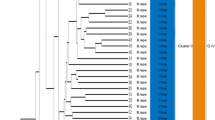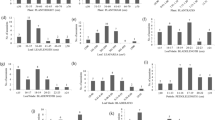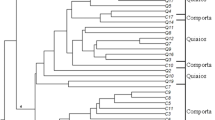Abstract
Brassica rapa (2n = 20, AA genome) is an important oil yielding species of the family Brassicaceae and characterized by wide range of genetic and morphological subtypes suitable for cultivation under diverse agro-climatic regions of India. In this study, genetic diversity among three subspecies of B. rapa including yellow sarson, toria and outlier brown sarson was estimated using various agro-morphological traits and simple sequence repeat (SSR) markers. Maximum variability was recorded for siliqua angle (Coefficient of variation = 30.9%), followed by seeds/siliqua (CV = 18.8%), leaf length (CV = 10%) and plant height (CV = 16.8%). Principal component analysis explained more than 50% of the total observed morphological variability for first two components. Of the 107 SSR markers tested, 80 generated reproducible, clear and distinct amplicons of which, 65 (81.25%) were found polymorphic. The number of alleles at each locus ranged from 2 to 7, with an average of 3.03 alleles per marker. A total of 197 alleles were detected at 65 SSR loci with average PIC value of 0.457 and a mean resolving power of 3.04. Neighbor-Joining cluster analysis based on morphological traits and SSR markers separately classified all the 28 genotypes into five major groups. The population structure analysis resulted into three sub-populations with certain extent of admixture among the earlier established taxonomic sub-groups. Twenty-three unique alleles were detected in thirteen B. rapa varieties. The clustering analysis and principal coordinate analysis outlined the genetic relationships among different varieties belonging to the three subspecies of B. rapa. Genetically diverse genotypes as illustrated by score plots and from the clustering patterns brought out the wide range of diversity present among B. rapa genotypes and the underlying options available for selecting parental genotypes for hybridization and developing high yielding cultivars suitable for Indian conditions.



Similar content being viewed by others

Abbreviations
- CV:
-
Coefficient of variation
- PC:
-
Principal component
- SSR:
-
Simple sequence repeat
- ISSR:
-
Inter simple sequence repeat
- RAPD:
-
Random amplified polymorphic DNA
- RFLP:
-
Restriction fragment length polymorphism
- AFLP:
-
Amplified fragment length polymorphism
- PIC:
-
Polymorphic information content
References
Abbas SJ, Farhatullah MK, Khan IA, Munir I (2009) Molecular analysis of genetic diversity in Brassica species. Pak J Bot 41(1):167–176
Abid G, Mingeot D, Udupa SM, Muhovski Y, Watillon B, Sassi K, M’hamdi M, Souissi F, Mannai K, Barhoumi F, Jebara M (2015) Genetic relationship and diversity analysis of faba bean (Vicia faba L. var. Minor) genetic resources using morphological and microsatellite molecular markers. Plant Mol Biol Rep. doi:10.1007/s11105-015-0871-0
Azad MK, Nasiri J, Abdollahi H (2013) Genetic diversity of selected Iranian quinces using SSRs from apples and pears. Biochem Genet 51:426–442
Bhajan B, Pant U, Khulbe RK, Singh AK (2013) New sources of variability for restructuring Brassica rapa. J Oilseed Brassica 4(1):53–56
Botstein D, White RL, Skolnick M, Davis RW (1980) Construction of a genetic linkage map in man using restriction fragment length polymorphisms. Am J Hum Genet 32:314–331
Carpio DPD, Basnet RK, De Vos RCH, Maliepaard C, Visser R, Bonnema G (2011) The patterns of population differentiation in a Brassica rapa core collection. Theor Appl Genet 122:1105–1118
Celucia SU, Pena RC, Villa NO (2009) B. rapa parachinensis (L.H. Bailey) Hanelt, and B. oleracea alboglabra (L.H. Bailey) Hanelt using simple sequence repeat markers. Philipp J Sci 138(2):141–152
Chuang HU, Tsao SJ, Lin JN, Chen KS, Liou TD, Chung MC, Yang YW (2004) Genetic diversity and relationship of non-heading chinese cabbage in taiwan. Bot Bull Acad Sin 45:331–337
Dossett M, Bassil NV, Lewers KS, Finn CD (2012) Genetic diversity in wild and cultivated black raspberry (Rubus occidentalis L.) evaluated by simple sequence repeat markers. Genet Resour Crop Evol 59:1849–1865
Evano G, Regnuat S, Goudet J (2005) Detecting the number of clusters of individuals using the software STRUCTURE: a simulation study. Mol Ecol 14:2611–2620
Ganesan SK, Singh R, Choudhury DR, Bhardwaj J, Gupta V, Singode A (2014) Genetic diversity and population structure study of drumstick (Moringa oleifera Lam.) using morphological and SSR markers. Ind Crop Prod 60:316–325
Govt of India (2014) Agricultural statistics at a glance. Directorate of Economics and Statistics, Department of Agriculture and Cooperation, Ministry of Agriculture, Govt. of India, New Delhi. http://cands.daenet.nic.in/PDF
Guo Y, Chen S, Li Z, Cowling WA (2014) Center of origin and centers of diversity in an ancient crop, Brassica rapa (Turnip rape). J Hered 105(4):555–565
Gupta N, Zargar SM, Gupta M, Gupta SK (2014) Assessment of genetic variation in Indian mustard (Brassica juncea L.) using PCR based markers. Mol Plant Breed 5(3):10–17
Hinata K, Prakash S (1984) Ethnobotany and evolutionary origin of indian oleiferous Brassicae. Indian J Genet 44:102–112
Karam MA, Morsi YS, Sammour RH, Ali RM (2014) Assessment of genetic relationships within Brassica rapa subspecies based on polymorphism. Int J Curr Microbiol Appl Sci 3(3):1–10
Khatun H, Rasul MG, Saikat MMH, Haque MM (2010) Genetic diversity in Brassica rapa L. Bangladesh J Plant Breed Genet 23(1):31–37
Kumar H, Anubha MKV, Lal JP (2011) Morphological and molecular characterization of Brassica rapa ssp. yellow sarson mutants. J Oilseed Brassica 2(1):1–6
Li WM, Barkley NA, Gillaspie GA, Pederson GA (2008) Phylogenetic relationships and genetic diversity of the USDA vigna germplasm collection revealed by gene-derived markers and sequencing. Genet Res 90:467–480
Martins S, Simoes F, Mendonca D, Matos J, Silva AP, Carnide V (2015) Western european wild and landraces hazelnuts evaluated by SSR markers. Plant Mol Biol Report. doi:10.1007/s11105-015-0867-9
McGrath JM, Quiros CE (1992) Genetic diversity at isozyme and RFLP loci in Brassica campestris as related to crop type and geographical origin. Theor Appl Genet 83:783–790
Nagaharu U (1935) Genomic analysis in Brassica with special reference to the experimental formation of B. napus and peculiar mode of fertilization. Jpn J Bot 7:389–452
Perrier X, Jacquemoud-Collet JP (2006) DARwin software. http://darwin.cirad.fr/darwin
Powell W, Morgante M, Andre C, Hanafey M, Vogel J, Tingey S, Rafalski A (1996) The comparison of RFLP, RAPD, AFLP and SSR (microsatellite) marker for germplasm analysis. Mol Breed 2:225–238
Prevost A, Wilkinson MJ (1999) A new system of comparing PCR primers applied to ISSR fingerprinting of potato cultivars. Theor Appl Genet 98:107–112
Pritchard JK, Wen W (2003) Documentation for the structure software, version 2. Department of Human Genetics, University of Chicago, Chicago. http://pritch.bsd.uchicago.edu/software
Pritchard JK, Stephens M, Donnelly P (2000) Inference of population structure using multilocus genotype data. Genetics 155:945–959
Ren JP, Dickson MH, Earle ED (2000) Improved resistance to bacterial soft rot by protoplast fusion between Brassica rapa and B. oleracea. Theor Appl Genet 100:810–819
Rohlf FJ (2000) NTSYS-pc Numerical taxonomy and multivariate analysis system, version 2.1a. Exeter Publ., Setauket, New York
Saha S, Molla MR, Chandra D, Rahman L (2008) Assessment of genetic variation and relationships within the varieties of four Brassica species by RAPD markers. Aust J Crop Sci 2(3):105–114
Shi W, Huang R, Zhou S, Xiong F (2011) Genetic diversity of 30 Cai-xins (Brassica rapa var. parachinensis) evaluated based on AFLP molecular data. Mol Plant Breed 7:41–47
Singh KH, Chauhan JS, Srivastava KK, Kumar PR (2003) Variability and character association in segregating generation of mustard. J Oilseeds Res 20:118–119
Singh KH, Misra AK, Kumar A (2006) Draft guidelines to conduct the tests for distinctness, uniformity and stability in rapeseed and mustard (Brassica). National Research Centre on Rapeseed Mustard, Sewar
Singh KH, Shakya R, Thakur AK, Chauhan DK, Chauhan JS (2013) Genetic diversity in indian mustard [Brassica juncea (L.) Czernj and Cosson] as revealed by agronomical traits and RAPD markers. Natl Acad Sci Lett 36(4):419–427
Singh KH, Shakya R, Mahawar RK (2014) Genetic diversity and patterns of variation among Indian mustard (Brassica juncea (L.) Czernj. and Cosson) varieties. SABRAO J Breed Genet 46(2):329–339
Sinhamahapatra SP, Raman RB, Roy S, Roy US, Raut NM, Ashok KV (2010) Breeding for an ideal plant type in yellow sarson (Brassica rapa L. yellow sarson). Electron J Plant Breed 1(4):689–694
Talebi R, Haghnazari A, Tabatabaei I (2010) Assessment of genetic variation within international collection of Brassica rapa genotypes using inter simple sequence repeat DNA markers. Biharean Biol 4(2):145–151
Thakur AK, Singh BK, Verma V, Chauhan JS (2013) Direct organogenesis in Brassica juncea var. NRCDR-2 and analysis of genetic uniformity using RAPD markers. Natl Acad Sci Lett 36:403–409
Thakur AK, Singh KH, Singh L, Nanjundan J, Rana MK, Singh D (2015) Transferability of SSR markers of Brassica species to some popular varieties of Brassica juncea. Proc Natl Acad Sci India Sect B Biol Sci. doi:10.1007/s40011-014-0486-5
Turi NA, Farhatullah RM, Shinwari ZK (2012) Genetic diversity in the locally collected Brassica species of Pakistan based on microsatellite markers. Pak J Bot 44(3):1029–1035
Varshney RK, Graner A, Sorrells ME (2005) Genic microsatellite markers in plants: features and applications. Trends Biotechnol 23:48–55
Wang et al. (Consortium on Brassica rapa genome sequencing) (2011). The genome of the mesopolyploid crop species Brassica rapa. Nat Genet 43:1035–1039
Xu J, Qian X, Wang X, Li R, Cheng X, Yang Y, Fu J, Zhang S, King GJ, Wu J, Liu K (2010) Construction of an integrated genetic linkage map for the A genome of Brassica napus using SSR markers derived from sequenced BACs in B. rapa. BMC Genom 11:594
Yasin JK, Mayadevi P (2010) Genetic diversity among commercial varieties of Anthurium andreanum Linden using RAPD markers. Plant Genet Transgenics 1(1):11–15
Yeh F, Boyle T (1997) Population genetic analysis of co-dominant and dominant markers and quantitative traits. Belg J Bot 129:157
Yildirim E, Yildirim N, Ercisli S, Agar G, Karlidag H (2010) Genetic relationships among turnip (Brassica rapa var. rapa) genotypes. Genet Mol Res 9(2):987–993
Zhang QP, Liu DC, Liu S, Liu N, Wei X, Zhang AM, Liu WS (2014) Genetic diversity and relationships of common apricot (Prunus armeniaca L.) in China based on simple sequence repeat (SSR) markers. Genet Resour Crop Evol 61:357–368
Zhao J, Wang X, Deng B, Lou P, Wu J, Sun R, Xu Z, Vromans J, Koornneef M, Bonnema G (2005) Genetic relationships between Brassica rapa as inferred from AFLP fingerprints. Theor Appl Genet 110:1301–1314
Acknowledgements
We sincerely thank the Director, ICAR-DRMR, Bharatpur, Rajasthan for providing all the necessary facilities to carry out this work. The authors acknowledge Indian Council of Agricultural Research, New Delhi for funding this research.
Author information
Authors and Affiliations
Corresponding author
Ethics declarations
Conflict of interest
The authors declare that they do not have any conflict of interest.
Electronic supplementary material
Below is the link to the electronic supplementary material.
Rights and permissions
About this article
Cite this article
Thakur, A.K., Singh, K.H., Singh, L. et al. Patterns of subspecies genetic diversity among oilseed Brassica rapa as revealed by agro-morphological traits and SSR markers. J. Plant Biochem. Biotechnol. 26, 282–292 (2017). https://doi.org/10.1007/s13562-016-0390-6
Received:
Accepted:
Published:
Issue Date:
DOI: https://doi.org/10.1007/s13562-016-0390-6



